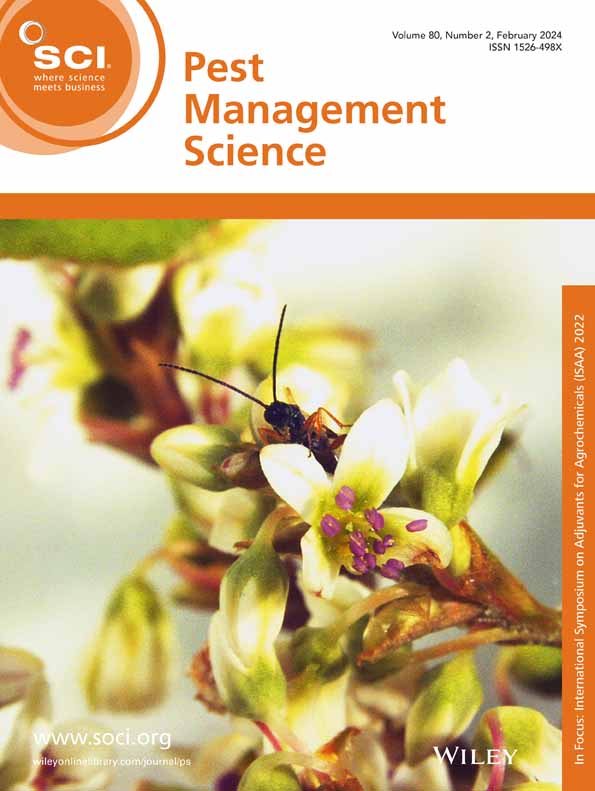苜蓿提取物对番茄病害的生物杀虫潜力及其非靶效应评价
IF 3.8
1区 农林科学
Q1 AGRONOMY
引用次数: 0
摘要
植物生物质生物活性化合物作为新型生态友好型生物农药的潜在替代品,在植物保护领域越来越受欢迎。本文对紫花苜蓿的三种提取物进行了制备、表征并评价了其对番茄病原菌的防治效果。此外,还对几种有益的捕食性螨的潜在非靶效应进行了评价。结果从紫花苜蓿地上部分离得到黄酮类化合物、皂苷类化合物及相应的促前素。黄酮类提取物中最丰富的成分为芹菜素和黄豆醇苷。皂苷主要由药原酸和zanic酸的bidesmo苷组成,而促apogenins仅由相应的单desmosidic化合物组成。在生物活性试验中,促生素能有效抑制交替孢和灰孢菌的菌丝生长和分生孢子萌发。同一混合物还显示出显著的体内防治交替菌病和灰霉病的效果,且呈剂量依赖性。黄酮类混合物是抗番茄斑病正孢子病毒效果最好的提取物,接种1个月后病毒滴度降低10 ~ 2倍。对作为生物防治剂的两种有益螨,persimilis Phytoseiulus和swblyseius swskii均未见毒副作用。结论黄酮类化合物与前apogenin复合物对番茄真菌和病毒具有生物农药活性;它们也被评估为对有益螨是安全的;这些结果支持了这些提取物在生物农药开发计划中的应用。©2025化学工业协会。本文章由计算机程序翻译,如有差异,请以英文原文为准。
Biopesticidal potential of alfalfa extracts against tomato diseases and assessment of their nontarget effects
BACKGROUNDBioactive compounds from plant biomasses are becoming increasingly popular in plant protection because of their potential application as new eco‐friendly biopesticide alternatives to agrochemicals. In this work, three extracts from Medicago sativa were prepared, characterized, and assessed for their efficacy in controlling some pathogens of tomato. The potential nontarget effects on selected beneficial predatory mites were also evaluated.RESULTSFlavonoids, saponins and the corresponding prosapogenins were obtained from the aerial parts of alfalfa. Apigenin and chrysoeriol glycosides were the most abundant constituents of the flavonoid extract. Saponins were composed mainly of bidesmosides of medicagenic and zanhic acids, whereas prosapogenins were composed only of the corresponding monodesmosidic compounds. In biological activity assays, prosapogenins effectively inhibited both the mycelial growth and conidia germination of Alternaria alternata and Botrytis cinerea . The same mixture also showed significant in vivo control efficacy against alternariosis and grey mold in a dose‐dependent manner. The flavonoid mixture was the best performing extract against tomato spotted wilt orthotospovirus, decreasing the virus titer by 10−2 fold one month post‐inoculation. Toxic effects were not observed on two beneficial mites used as biological control agents, Phytoseiulus persimilis and Amblyseius swirskii .CONCLUSIONFlavonoid and prosapogenin mixtures displayed biopesticide activity against fungi and virus in tomato; they were also evaluated as safe towards beneficial mites; these results support the application of these extracts in biopesticide development programs. © 2025 Society of Chemical Industry.
求助全文
通过发布文献求助,成功后即可免费获取论文全文。
去求助
来源期刊

Pest Management Science
农林科学-昆虫学
CiteScore
7.90
自引率
9.80%
发文量
553
审稿时长
4.8 months
期刊介绍:
Pest Management Science is the international journal of research and development in crop protection and pest control. Since its launch in 1970, the journal has become the premier forum for papers on the discovery, application, and impact on the environment of products and strategies designed for pest management.
Published for SCI by John Wiley & Sons Ltd.
 求助内容:
求助内容: 应助结果提醒方式:
应助结果提醒方式:


